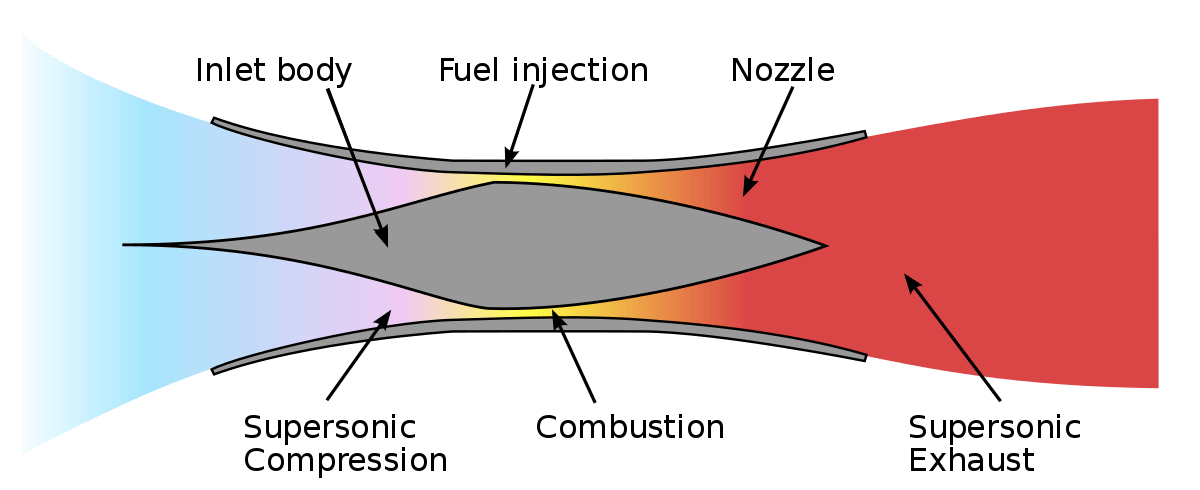What Is A Scramjet?
A scramjet is short for a supersonic combustion ramjet. It is a variant of the ramjet airbreathing jet engine. In this engine, the process of combustion occurs in supersonic airflow. Scramjets usually rely on high vehicle speed, just like ramjets, in order to compress the air coming in forcefully before combustion. This is precisely why it got the name of “Ramjet.” It is also pertinent to note here that in a scramjet; the airflow is supersonic across the entire engine as opposed to a ramjet where it decelerates the air significantly before combustion to subsonic velocities. This is what enables scramjets to be able to operate at incredibly high speeds efficiently and without any hiccups.
History of The Scramjet Engine By ISRO
In the present times, we launch satellites into the orbit using Satellite Launch Vehicles (SLV) that are multi-staged and can only be used once which means that they are expendable. All these launch vehicles have oxidizer in addition to fuel that is meant for combustion in order to produce thrust. The launch vehicles that are designed for only one-time use are usually rather expensive. In addition to that, they have low efficiency due to the fact that they can only carry 2-4% of their total lift-off mass with themselves to the Earth’s orbit. Therefore, a lot of effort goes into reducing the cost of launch.
The Scramjet Engine of ISRO had its first experimental mission on 28th August 2016 from Sriharikota. The launch took place from the Satish Dhawan Space Center SHAR for an Air Breathing Propulsion System. After 300 seconds of flight, the vehicle landed in the Bay of Bengal which is approximately at a distance of 320 kilometers from Sriharikota. Throughout its flight, the vehicle was tracked successfully from the ground stations present at Sriharikota. Thanks to this flight, many crucial technologies like the air-breathing engines’ ignition at supersonic speed and air intake mechanism have been demonstrated successfully. Many other technologies such as fuel injection systems and holding flames at supersonic speed have also shown a lot of success.
ISRO has designed the Scramjet Engine, and it makes use of oxygen derived from the atmospheric air as well as hydrogen as a fuel as the oxidizer. This particular test can be regarded as the maiden experimental test of a rather short duration of the Scramjet Engine of ISRO. This hypersonic flight was launched at 2058 m/s. The Advanced Technology Vehicle (ATV) of ISRO is a rocket with an advanced sound. This was a robust rocket booster that was put to use for testing Scramjet Engines in supersonic conditions. The ATVs that carried Scramjet Engines have been reported to weigh 3277 kilograms during liftoff.
After the wild success of the RLV – TD in October 2016, ISRO tested a Scramjet Engine that was based on the air-breathing propulsion. Its test flight took place at Sriharikota from the Satish Dhawan Space Center. The flight was named the Advanced Technology Vehicle (ATV) and consisted of a scramjet engine with a two-stage RH-560 or a sounding rocket.
Atmospheric Oxygen
It is no secret that conventional rocket engines have to carry both oxidizer and fuel on board that is meant for combustion in order to produce thrust. On the contrary, scramjets get oxygen from the atmosphere. They do it by compressing the air coming in at hypersonic speed before combustion. It is possible for the Scramjet Engine to liquify the oxygen present in the atmosphere and then store it onboard. It is also noteworthy that the analysis of the test flight of the RLV – TD post-flight showed encouraging results.
Scramjet Programs
They refer to testing and research programs for developing supersonic combustion ramjets also called Scramjets. There are several national and international collaborations as well as military and civilian programs. Scramjet technologies have been successfully developed in Russia, China, India and the United States of America.
Bottom Line
ISRO’s Scramjet Engine has succeeded in making India proud. With the successful launch of Scramjet, India became the fourth country to have this technology. It is one of the most important milestones of ISRO. It has laid a solid foundation for India to develop and design a more advanced engine with the airbreathing technology. It is amazing that ISRO has been so consistent in its expansion and has been at the forefront of all the developments related to space programs around the world. It has many documented as well as undocumented achievements to its credit that make Indians proud. ISRO also collaborates with the Space organizations of other countries and shares a good relationship with them all. Sharing of knowledge is essential when it comes to the developments in this field. It is also safe to say that thanks to ISRO, India today has its very own space observatory.





